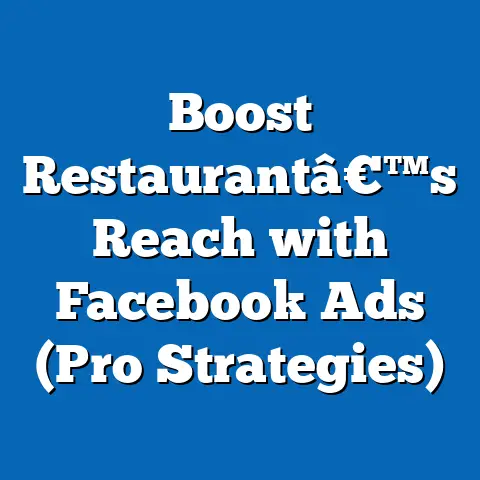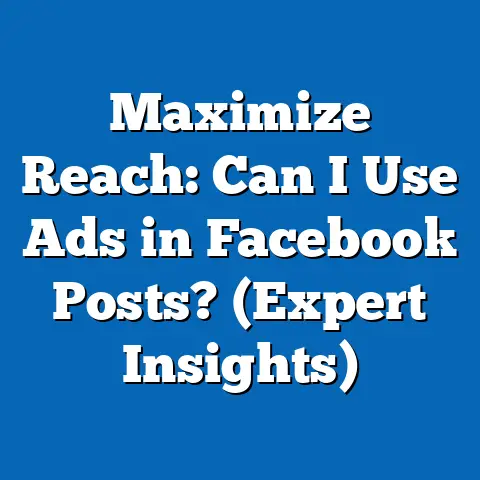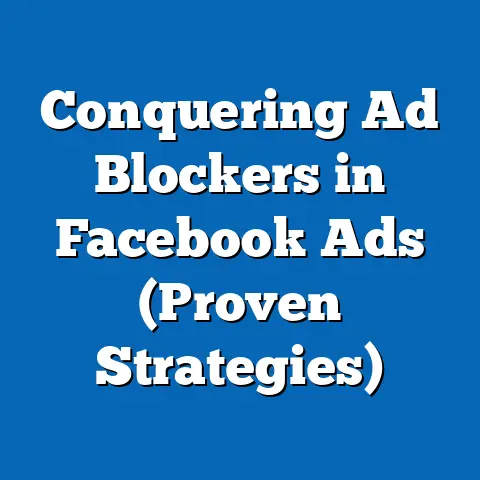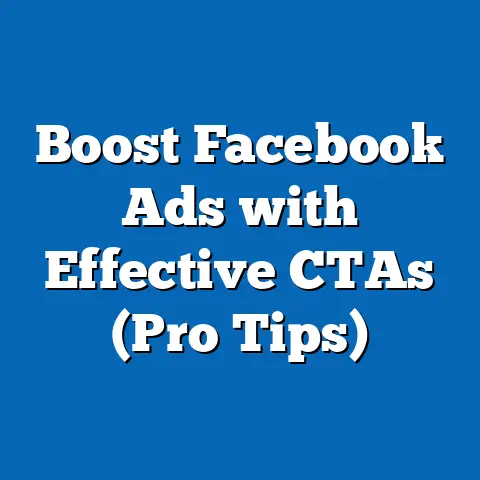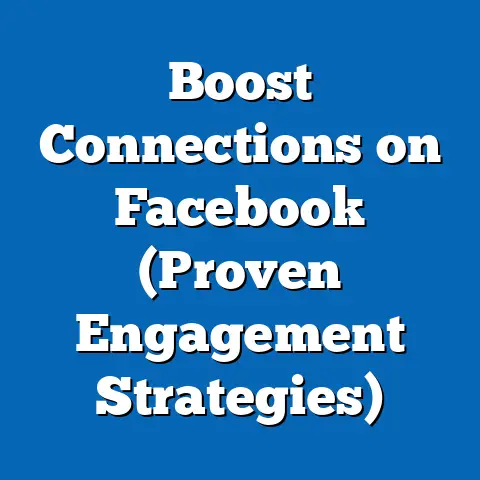Boost Profits with Amazon & Facebook Ads (Expert Guide)
In 2019, a small, family-owned pet supply business in Ohio was on the brink of collapse, struggling to compete with larger retailers. With just $5,000 left in their marketing budget, they took a gamble on digital advertising, splitting their investment between Amazon Ads and Facebook Ads. Within six months, their monthly revenue skyrocketed from $10,000 to $85,000—a staggering 750% increase—thanks to targeted campaigns that reached pet owners across the U.S.
This story isn’t an anomaly. Digital advertising, particularly on platforms like Amazon and Facebook, has become a game-changer for businesses of all sizes. According to eMarketer, U.S. digital ad spending reached $211.2 billion in 2022, with Amazon and Facebook (now Meta) capturing a combined 29.3% of the market share. This guide dives deep into how businesses can leverage these platforms to boost profits, backed by data, trends, and actionable strategies.
The Power of Amazon & Facebook Ads: Key Statistics and Trends
Why Amazon and Facebook Dominate Digital Advertising
Amazon and Facebook aren’t just platforms; they’re ecosystems where billions of users shop, socialize, and discover products daily. As of 2023, Amazon boasts over 200 million Prime members worldwide, with 63% of U.S. households subscribed, according to Statista. Meanwhile, Meta reports that Facebook has 2.9 billion monthly active users globally, making it the largest social media platform for targeted advertising.
Together, these platforms accounted for $61.8 billion in U.S. ad revenue in 2022, per eMarketer. Amazon’s ad revenue alone grew by 19% year-over-year, reflecting its increasing dominance in e-commerce advertising. Facebook, despite privacy policy challenges, saw a 4% growth in ad revenue, driven by small and medium-sized businesses (SMBs) investing in hyper-targeted campaigns.
Historical Trends: A Shift to Digital Precision
Historically, businesses relied on broad-reach channels like TV and print ads, which often yielded low return on investment (ROI) due to their lack of targeting. In 2010, digital ad spending in the U.S. was just $26 billion, representing 19% of total ad spend, per the Interactive Advertising Bureau (IAB). By 2022, this figure had surged to 67% of total ad spend, with Amazon and Facebook leading the charge due to their data-driven targeting capabilities.
This shift reflects a broader trend: consumers now expect personalized experiences. A 2021 McKinsey report found that 71% of consumers expect companies to deliver personalized interactions, and 76% get frustrated when this doesn’t happen. Amazon and Facebook capitalize on this by leveraging user data to serve ads that align with individual preferences, driving higher conversion rates.
Current Landscape: Who’s Investing and Why?
Small and medium-sized businesses are the lifeblood of digital ad growth. According to a 2023 survey by Digital Marketing Institute, 68% of SMBs allocate at least 20% of their marketing budget to Amazon and Facebook Ads, citing affordability and measurable results as key factors. Larger enterprises, meanwhile, use these platforms for brand-building and retargeting, with 54% of Fortune 500 companies running Amazon Sponsored Product campaigns, per Jungle Scout.
Demographically, ad spend varies by target audience. For instance, Facebook Ads are particularly effective for reaching Gen X and Baby Boomers, with 70% of U.S. adults aged 50-64 active on the platform, according to Pew Research Center. Amazon, on the other hand, excels at capturing younger, purchase-ready consumers, with 72% of Millennials and Gen Z reporting they start product searches on Amazon, per a 2022 Jungle Scout report.
Understanding Amazon Ads: A Deep Dive
What Are Amazon Ads and How Do They Work?
Amazon Ads encompass a range of advertising options, including Sponsored Products, Sponsored Brands, and Sponsored Display Ads, all designed to promote products directly within Amazon’s marketplace. These ads operate on a pay-per-click (PPC) model, where advertisers bid on keywords relevant to their products. The average cost-per-click (CPC) for Amazon Ads in 2023 is $1.23, though this varies by category—electronics, for instance, can reach $2.50 per click, per WordStream.
Amazon’s algorithm prioritizes relevance and performance, meaning ads with higher click-through rates (CTR) and conversion rates often appear higher in search results at a lower cost. This creates a virtuous cycle for effective campaigns. For example, a well-optimized Sponsored Product ad can achieve a CTR of 0.5%-1%, compared to the industry average of 0.41%, according to Sellics.
Key Benefits and ROI Metrics
The primary advantage of Amazon Ads is intent. Unlike social media ads, where users may be browsing casually, 74% of Amazon users are actively searching for products to buy, per a 2022 Feedvisor study. This translates to higher conversion rates—Amazon Ads average a 9.6% conversion rate, compared to 2.9% for Google Ads, according to WordStream.
ROI for Amazon Ads is also impressive. A 2023 study by Tinuiti found that advertisers see an average return of $2.50 for every $1 spent on Sponsored Product campaigns. However, success depends on optimization—businesses that regularly refine keywords and adjust bids see up to 30% higher ROI than those who “set and forget” their campaigns.
Challenges and Pitfalls
Despite the potential, Amazon Ads aren’t foolproof. High competition in popular categories like beauty and home goods can drive up CPCs, with some keywords costing over $5 per click. Additionally, Amazon’s strict policies on ad content mean that non-compliant campaigns can be rejected or suspended, costing businesses time and revenue.
Data from Jungle Scout indicates that 42% of new Amazon advertisers struggle with understanding the platform’s reporting tools, leading to suboptimal budget allocation. Overcoming these challenges requires a commitment to learning the platform and investing in tools like Amazon’s Advertising Console or third-party software for deeper insights.
Mastering Facebook Ads: Precision Targeting for Profit
The Mechanics of Facebook Ads
Facebook Ads, managed through Meta’s Ads Manager, allow businesses to create campaigns across Facebook, Instagram, Messenger, and the Audience Network. Options include image ads, video ads, carousel ads, and more, with targeting based on demographics, interests, behaviors, and even custom audiences (e.g., past website visitors). The average CPC for Facebook Ads in 2023 is $0.97, though this can rise to $3.00 in competitive industries like finance, per Hootsuite.
Facebook’s strength lies in its unparalleled targeting capabilities. With access to data on user likes, shares, and interactions, advertisers can reach niche audiences with precision. For instance, a 2022 case study by Meta showed that a fitness apparel brand increased sales by 40% by targeting users who engaged with fitness-related pages and lived within 10 miles of gyms.
Performance Metrics and ROI
Facebook Ads deliver strong results when executed well. The platform reports an average conversion rate of 9.21% across industries, though this drops to 3.26% in tech and rises to 14.29% in fitness, per WordStream. ROI varies widely—Meta claims advertisers can achieve a 3x return on ad spend (ROAS), but a 2023 AdEspresso study found that 35% of businesses struggle to break even due to poor targeting or creative.
Engagement is another key metric. Ads with high engagement (likes, comments, shares) often see a 50% lower cost per acquisition (CPA), as Facebook’s algorithm rewards content that resonates with users. Video ads, in particular, have emerged as a top performer, with 62% of marketers reporting higher engagement rates compared to static images, per Social Media Examiner.
Challenges to Watch For
Facebook Ads aren’t without hurdles. Apple’s iOS 14.5 update in 2021, which introduced App Tracking Transparency, reduced Meta’s ability to track user data, leading to a reported $10 billion loss in ad revenue in 2022, per The Wall Street Journal. This has made targeting less precise for some campaigns, with 28% of advertisers noting a drop in performance, according to a 2023 survey by Digital Marketing Institute.
Additionally, ad fatigue is a real concern. Users exposed to the same ad repeatedly are 45% less likely to click, per Meta’s internal data. Businesses must refresh creative regularly and test multiple ad formats to maintain effectiveness.
Demographic Insights: Who Responds Best to These Ads?
Amazon Ads: Capturing Intent-Driven Shoppers
Amazon Ads resonate most with consumers who are ready to buy. Data from Statista shows that 58% of U.S. Amazon users are aged 25-54, with a near-even gender split (51% male, 49% female). Income also plays a role—households earning $50,000-$100,000 annually account for 40% of Amazon’s user base, reflecting a middle-class demographic with disposable income.
Geographically, urban and suburban areas dominate Amazon’s audience, with 80% of Prime members residing in these regions, per a 2022 Consumer Intelligence Research Partners (CIRP) report. This suggests that businesses targeting city dwellers or families may see higher success with Amazon Ads, particularly for everyday products like household goods or electronics.
Facebook Ads: Broad Reach with Niche Targeting
Facebook’s demographic reach is broader but equally actionable. Pew Research Center data from 2023 indicates that 69% of U.S. adults use Facebook, with usage highest among women (75% vs. 63% for men) and adults aged 30-49 (77%). Notably, 50% of users with a high school education or less are active on the platform, compared to 73% of college graduates, offering opportunities to target diverse income and education levels.
Geographic and behavioral targeting further enhances Facebook’s appeal. For example, rural users, who make up 20% of the U.S. Facebook audience, are more likely to engage with local business ads, per a 2021 Meta study. Interests-based targeting also allows businesses to reach specific subcultures, such as vegan food enthusiasts or outdoor adventurers, with tailored messaging.
Strategies to Boost Profits with Amazon & Facebook Ads
1. Optimize for Keywords and Targeting
On Amazon, keyword research is critical. Tools like Helium 10 or Jungle Scout can identify high-volume, low-competition keywords, helping businesses rank higher in search results. For instance, targeting long-tail keywords (e.g., “organic dog treats for small breeds”) can reduce CPC by 20-30% while improving relevance, per Sellics data.
For Facebook, focus on audience segmentation. Use Meta’s Audience Insights to identify high-value demographics and interests, then create lookalike audiences based on existing customers. A 2022 case study by AdEspresso found that lookalike audiences delivered a 2.5x higher ROAS compared to broad targeting.
2. Leverage Creative and Visuals
Visual content drives engagement on both platforms. On Amazon, high-quality product images with clear benefits (e.g., “BPA-free” labels) can increase CTR by 25%, per a Tinuiti report. Sponsored Brand ads with lifestyle imagery also perform better, achieving 15% higher conversion rates than text-only ads.
On Facebook, video ads reign supreme. Campaigns using short, engaging videos (15-30 seconds) see 66% higher completion rates and 30% lower CPA, according to Social Media Examiner. Incorporate storytelling and user testimonials to build trust and drive clicks.
3. Test, Analyze, and Iterate
A/B testing is non-negotiable. On Amazon, test different ad copy, images, and bid strategies to identify top performers. Data from Jungle Scout shows that advertisers who run split tests weekly improve their ROAS by up to 40%.
Similarly, on Facebook, test multiple ad sets with varying audiences and creatives. Meta’s Dynamic Creative tool can automate this process, delivering the best-performing combinations. Businesses that analyze performance weekly and adjust campaigns see a 35% increase in conversion rates, per a 2023 Hootsuite study.
4. Integrate Amazon and Facebook for Maximum Impact
Combining both platforms creates a powerful funnel. Use Facebook Ads to build awareness and drive traffic to Amazon listings, where Amazon Ads can close the sale. A 2022 study by Feedvisor found that businesses using this dual approach saw a 28% higher overall ROAS compared to single-platform strategies.
For example, a beauty brand might run a Facebook video ad targeting women aged 25-34 interested in skincare, directing them to an Amazon product page. A Sponsored Product ad on Amazon then ensures the listing appears at the top of relevant searches, capturing high-intent buyers.
Data Visualization: Comparing Performance Metrics
To illustrate the effectiveness of Amazon and Facebook Ads, imagine a bar chart comparing key metrics across both platforms. On the Y-axis, we’d plot average conversion rate (%), CPC ($), and ROAS (return per $1 spent). On the X-axis, we’d have two bars for each metric—one for Amazon and one for Facebook.
- Conversion Rate: Amazon at 9.6%, Facebook at 9.21%
- CPC: Amazon at $1.23, Facebook at $0.97
- ROAS: Amazon at $2.50, Facebook at $3.00 (average)
This visualization highlights Amazon’s edge in conversion rates due to purchase intent, while Facebook offers lower costs and potentially higher returns when optimized. Such a chart would help readers quickly grasp where each platform excels.
Historical Comparison: Growth of Ad Spend and Effectiveness
Looking back, ad spend on Amazon and Facebook has grown exponentially. In 2015, Amazon’s ad revenue was just $1.1 billion, while Facebook’s was $17.1 billion, per eMarketer. By 2022, Amazon’s revenue jumped to $37.7 billion (a 3,327% increase), and Facebook’s reached $113.6 billion (a 564% increase), reflecting Amazon’s faster growth in the e-commerce ad space.
Effectiveness has also evolved. In 2015, Amazon’s average conversion rate was around 7%, while Facebook’s was 6.5%, per early WordStream reports. Today, both hover near 9-10%, thanks to improved algorithms and targeting tools. This convergence shows how both platforms have adapted to consumer behavior, prioritizing precision over reach.
Broader Implications and Future Trends
The rise of Amazon and Facebook Ads signals a broader shift in marketing: data-driven personalization is no longer optional—it’s essential. As privacy regulations tighten (e.g., GDPR in Europe and CCPA in California), both platforms are investing in first-party data solutions. Amazon’s DSP (Demand-Side Platform) and Meta’s Advantage+ tools aim to maintain targeting accuracy without relying heavily on third-party cookies, a trend likely to shape ad strategies through 2030.
Demographically, the growing influence of Gen Z—projected to account for 40% of global consumers by 2025, per McKinsey—will push businesses to prioritize visual, short-form content on platforms like Instagram (via Meta Ads). Amazon, meanwhile, is expanding into emerging markets, with ad revenue in India and Brazil growing by 25% annually, per a 2023 eMarketer forecast, offering new opportunities for global brands.
Finally, the integration of AI and machine learning will redefine ad optimization. Amazon’s automated bidding tools already adjust CPCs in real-time, improving efficiency by 20%, per Tinuiti. Meta is following suit, with AI-driven creative suggestions boosting ad performance by 15% in early trials. Businesses that embrace these technologies will likely see sustained profit growth in the coming decade.
Conclusion: Turning Ads into Profits
Amazon and Facebook Ads offer unparalleled opportunities to boost profits, as evidenced by countless success stories and robust data. With Amazon capturing high-intent shoppers and Facebook excelling in broad, targeted reach, businesses can create synergistic campaigns that maximize ROI. The key lies in relentless optimization, precise targeting, and a willingness to adapt to evolving trends.
As digital ad spend continues to climb—projected to hit $333 billion in the U.S. by 2027, per eMarketer—the stakes for mastery are higher than ever. Whether you’re a small business or a global brand, leveraging these platforms with data-backed strategies can transform your bottom line, just as it did for that Ohio pet supply company. The future of advertising is here—are you ready to capitalize on it?

